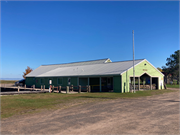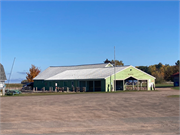| Additional Information: | A 'site file' exists for this property. It contains additional information such as correspondence, newspaper clippings, or historical information. It is a public record and may be viewed in person at the Wisconsin Historical Society, State Historic Preservation Office.
2023:
Architecture:
The Ehlers Fish Shed, also known as the “Green Shed,” is a one-story astylistic utilitarian building constructed around c.1938 as a fish processing shed for the independent fishing firms that ran boats out of Cornucopia, Wisconsin. The main block of the shed is a long, one-story building that was extended with a one-story open pavilion in 1999. The building has a low-pitched gable roof covered with modern standing seam metal with exposed rafters under the eaves. Historic photos show that originally the building was covered with a standing seam metal roof that was later covered with asphalt shingles.
The walls of the original section of the building have wood lap siding and similar lap siding was used in 1999 on the areas between the openings of the pavilion addition. On one side wall of the original building there are four small openings filled with four light windows and an entrance covered with a modern steel door and screen door. Also on this elevation, is a small, shallow, projecting rectangular ell.
The other side wall of the original building has several four light windows along about half of the wall. The other half of the wall projects into a long shed-roofed ell that continues to the point that the pavilion begins. This ell has three large openings covered on the inside with plywood and a smaller opening filled with a six-light window.
On the main elevation, behind the pavilion, there is an entrance into the museum consisting of a modern paneled door and screen door, and an older large opening covered with a sliding door made up of vertical wood boards. The rear elevation has a plain wall with an opening in the gable peak covered with a sliding door made up of lap siding.
Based on historic photos, the interior of the shed was utilitarian, with unfinished walls and large tables used to process fish. The interior is currently museum space and has a dropped acoustical tile ceiling with fluorescent light panels, a sealed concrete floor, and drywall along the walls. There are a number of exhibit fixtures, including some that somewhat divide the space, although the overall interior space still appears as a large open area.
History:
The Ehlers Fish Shed or “Green Shed” was built around 1938 for Herman Ehlers and his son Alton, who recognized a need to create a large space for the independent fishing firms in Cornucopia to process their catches, particularly during the large herring run in the fall.
Harbors in Cornucopia and Bayfield held the largest fishing fleets along Wisconsin’s Lake Superior shoreline during the 20th century. The abundance of herring in the waters off of Cornucopia resulted in its industrial fishing era. After lumbering ended in the area around 1900, Tom and Charles Hinks teamed up with Carl and Andrew Hansen in 1909 to take advantage of the local herring run. Soon, a number of small, independent, fishing firms were fishing for herring, along with plentiful lake trout, whitefish, and chubs. Between 1910 and 1920, these independent fishing firms were under the control of large packing houses, specifically the A. Booth Packing Company of Chicago. Booth dominated the Lake Superior fishing industry until after World War I, controlling the prices for fish because they controlled the transport of fish by rail to markets in Milwaukee and Chicago.
In the 1920s, this monopoly was broken largely by Herman Ehlers of the Flieth-Ehlers General Store, who began to use trucks to transport fish to Bayfield and independently arrange for shipping to Milwaukee or Chicago. The fishing firms in Cornucopia formed a loose association to market their fish through Ehlers, who took a small percentage of the total profits for a catch, thereby stabilizing prices and providing a more consistent living for fishing families of the area.
Between 1926 and 1936, over 11,000,000 pounds of fish were taken by Cornucopia fishing firms and in the last three weeks of 1936, over 1,000,000 pounds of herring were caught. The small fishing firms of Cornucopia processed their fish in small sheds, but with the number of fish caught rising during the 1930s, Herman Ehlers had the “Green Shed” built so that the fishing firms could efficiently and cooperatively handle their large catches.
Overall, Great Lakes fishing began to decline in the early 20th century, but in Cornucopia, fishing continued to flourish until the 1960s, primarily due to the continued success of the herring runs every fall. For example, between 1941 and 1948, an average of 1.5 to 2 million pounds of fish were harvested by Cornucopia fishing firms each year and 75% of this amount was the herring catch. The use of the “Green Shed” by all the fishing firms in Cornucopia made it easier for fish to be processed and marketed by Ehlers.
By the 1960s, overfishing and the growth of predatory species in Lake Superior resulted in a decline of fishing in Cornucopia. The “Green Shed” closed in the late 1960s and stood mostly vacant until 1999, when the local community decided to use the building for a museum related to the fishing industry. In that year, the pavilion was added to provide space for community activities and by the 2003 centennial of Cornucopia’s founding, the building was converted into a museum. Today (2023), the museum is part of a small, but thriving, shoreline commercial area that includes small businesses, some of which are housed in very small old fishing related sheds. The economy of the small community is now centered around tourism and recreation.
|
|---|





